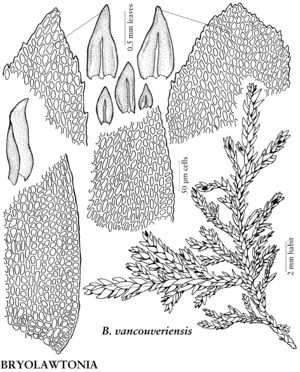Bryolawtonia
Bryologist 93: 329. 1990.
| Taxon | Illustrator ⠉ | |
|---|---|---|
 | Bryolawtonia vancouveriensis | Patricia M. Eckel |
Plants small, frondose, dark green to olive green or brownish, glossy. Stems creeping, irregularly branched along stem; paraphyllia absent. Secondary stem and branch leaves imbricate, ovate to elliptic, at least some asymmetric, flat, not plicate; margins serrate distally, teeth recurved; apex rounded-obtuse; costa single, ending before apex; laminal cells short-elliptic, walls not pitted. Sexual condition dioicous; perichaetial inner leaves ligulate-lanceolate. Seta 0.5–1 cm. Capsule cylindric; exostome teeth linear, horizontally striate basally, low-papillose distally; endostome basal membrane 1/4 total length, segments slightly papillose. Spores 12–15 µm.
Distribution
w North America
Discussion
Species 1.
Bryolawtonia has complanate leaves with broadly rounded, serrulate margins. In the field, Bryolawtonia can be confused with Dacryophyllum falcifolium, an endemic genus of Hypnaceae restricted to the central California coast. Dacryophyllum is similar in size to Bryolawtonia but differs in its cultriform-asymmetric leaves, unlike the almost symmetric-leaved Bryolawtonia. Porotrichum bigelovii of west coastal North America has complanate leaves with broadly rounded, dentate apices, but that species is markedly larger than Bryolawtonia vancouveriensis, and has leaves appearing asymmetric as a result of broad recurvature of the postical margin.
Selected References
None.